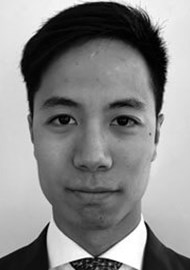As we emerge from the impact of the COVID-19 pandemic on the first half of 2020, trainee colleagues will be looking to their future once again. Options may include fellowships, and we are delighted to have Dr Andrew Ma share his experiences.
Sydney is a city which needs no introduction and is known the world over for its famous beaches and iconic harbour. As a Canadian-trained medical graduate, Australia is about as far away as one can go for fellowship training. Yet, despite being over 15,000km from home, my wife and I quickly settled in and fell in love with the sprawling metropolis.
Similar to our hometown of Toronto, Sydney boasts a highly multicultural populace, a diverse restaurant scene, and world-class art and culture. Add to that the year-round sunshine, easy-going lifestyle, and the picturesque Sydney harbour, and you have a winning formula.
“I did more exostectomies in the first few months of fellowship than in five years of residency in Canada!”
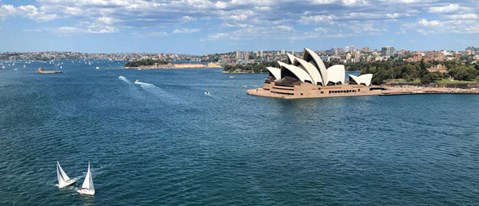
View of the famous Sydney Opera House taken from the Harbour Bridge.
The Sydney Endoscopic Ear Surgery (SEES) Research Group offers a one-year fellowship in endoscopic ear surgery (EES), spanning February to January of the following year. Applications are made online through the SEES website. The SEES group consists of four otologists with high-volume endoscopic ear practices : A/Prof Nirmal Patel, A/Prof Jonathan Kong, A/Prof Alex Saxby, and A/Prof Nicholas Jufas. In this review, I share my experience, and encourage those who are interested to pursue a fellowship with the SEES group.
The operating microscope has been the workhorse in otology for decades; EES is quickly gaining traction globally. The endoscope boasts a wide-angle view of the external auditory canal and middle ear space, overcoming line-of-sight limitations of the microscope. By dramatically improving visualisation, it enables the surgeon to see difficult-to-visualise spaces (e.g. sinus tympani, mastoid antrum), while also preserving normal anatomy that would have been removed to improve visualisation. EES is particularly advantageous in surgeries such as tympanoplasty and cholesteatoma. Of course, there are certain disadvantages – loss of 3D vision and one-handed surgery are frequently cited, but with ample practice, these shortcomings can be overcome. With the growing adoption of EES, many otology/neurotology fellowship programmes now offer some exposure to it. At the time of writing, the SEES Fellowship represents the first endoscope-focused otology fellowship in the world.
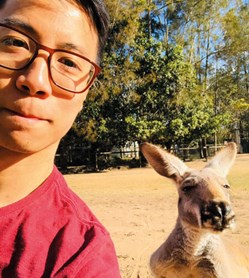
Hanging out with the local wildlife at Lone Pine Koala Sanctuary in Brisbane.
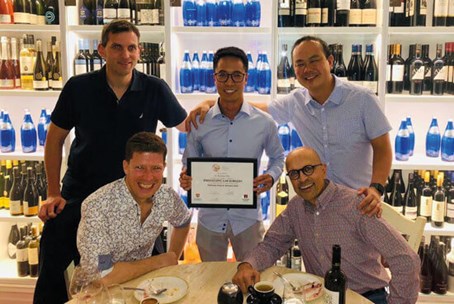
Celebrating the completion of the 2019-2020 fellowship. (Back L-R): Nicholas Jufas,
Andrew Ma and Jonathan Kong. (Front L-R): Alex Saxby and Nirmal Patel.
Coming from Canada, one of the major differences is the co-existence of a public and private healthcare system. This is in contrast to the single-payer system to which I am accustomed. The fellowship was structured with time spent in both systems. Monday would be spent in the public system at the Royal North Shore Hospital with the ENT registrars. My role in the public system was to act as the attending surgeon (with oversight from the consultant), overseeing and teaching the registrars in public otology surgical cases. Otology outpatient clinics were held every second Monday afternoon, with some 20-30 otology outpatients to be assessed by the team.
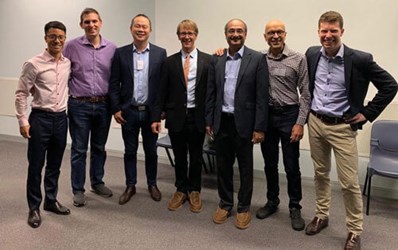
The 6th Sydney Endoscopic Ear Dissection Course faculty (L-R):
Andrew Ma, Nicholas Jufas, Jonathan Kong, Adrian James,
Arunachalam Iyer, Nirmal Patel and Alex Saxby.
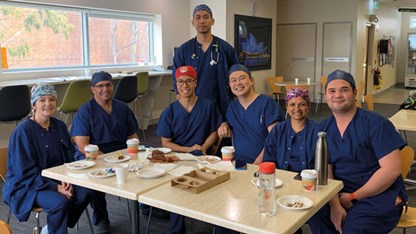
Surgeons, anesthesiologists, and nurses taking a team break
between cases at the North Shore Private Hospital.
The remainder of the week was spent operating in the private hospitals with the various consultants, translating to an average of three to five operating days per week. As the private hospitals do not have ENT registrars, this meant significant high-quality one-on-one time with the consultant. Another stark difference from the Canadian system is that there were no specified end-times - the latest elective OR I was in went until 10:30pm! With so much face time, I quickly learned each consultant’s OR peculiarities, such as draping, instrument selection, restaurant preferences, and taste in music! Strong karaoke skills are an asset.
“Another benefit to having four mentors was the opportunity to appreciate different techniques and to pick and choose those that felt most natural to me”
The SEES fellowship provides a very high caseload. My 12-month operating logbook included over 400 otology cases, with just shy of 300 involving the endoscope. Although the fellowship is endoscope-focused, there was no hesitation to involve the operating microscope when indicated.
My logbook was as follows:
- Tympanoplasty – 179
- Ossiculoplasty – 105
- Primary cholesteatoma – 65
- Mastoidectomy – 41
- Stapedotomy – 40
- Cochlear implant – 43
- Exostectomy – 28 (I did more exostectomies in the first few months of fellowship than in five years of residency in Canada!)
One of the challenges in adopting EES is the required learning curve. Most ENT surgeons are adept with functional endoscopic sinus surgery (FESS), but while endoscopic skills are transferable, the tight space of the ear canal and middle ear pose a different challenge. The literature on procedural learning curve suggests competency can be achieved with approximately 50-60 cases [1]. Given the high endoscopic volumes, I felt my skills ramp up quickly, simply as a product of constant immersion in the OR – a luxury that few trainees enjoy. Another benefit to having four mentors was the opportunity to appreciate different techniques and to pick and choose those that felt most natural to me.
Personally, I felt comfortable with simpler procedures (tympanoplasty, ossiculoplasty) within the first half of the fellowship, while more advanced procedures such as cholesteatoma and stapedotomy became more competent in the second half.
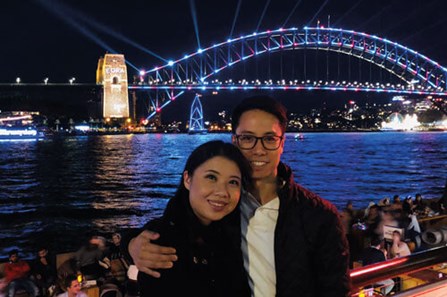
Andrew and wife, Annie, with the Sydney Harbour Bridge during the Sydney Vivid light festival.
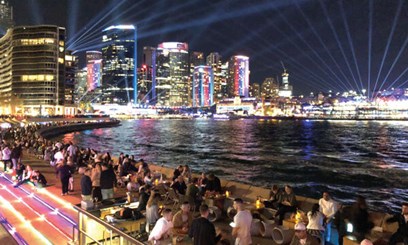
Sydney’s bustling CBD during the Sydney Vivid light festival.
There were also opportunities for some skull base procedures, including vestibular schwannoma, lateral temporal bone resection, resection of endolymphatic sac tumour, and plugging of superior canal dehiscence. As an added bonus, I would occasionally do some general ENT procedures, such as septoplasty, turbinoplasty, and FESS – great to keep up one’s non-otology skillset!
The SEES group is also actively involved in research, and all members maintain an updated database of EES outcomes. There is ample research support with the four otologists holding academic appointments at the University of Sydney and/or Macquarie University. I had the opportunity to present our research at the 3rd World Congress of Endoscopic Ear Surgery in Boston, as well as the Asia-Pacific Symposium on Cochlear Implantation in Tokyo.
As a fellow, I was also involved in the Sydney Endoscopic Ear Dissection Course which alternates annually between the Royal North Shore Hospital and Royal Prince Alfred Hospital. It was a wonderful opportunity to be able to help teach dissection principles and techniques in EES. The SEES Dissection Course is a sell-out year after year, with many international attendees and all levels of experience, making for an engaging and rewarding weekend.
“The SEES Fellowship represents the first endoscope-focused otology fellowship in the world”
It is important to note that the amount of paperwork required to become credentialed in Australia is herculean, and one should expect to hound AHPRA (the national regulatory authority) regularly to ensure your application is processed in time to start. The fellowship is funded through surgical assistant fees. To qualify, the fellow must register through AHPRA and Medicare to submit invoices.
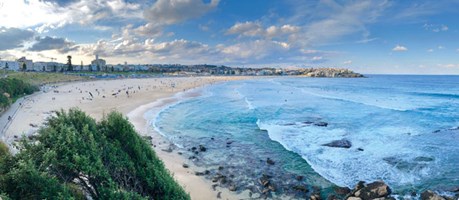
World-renowned Bondi Beach.
Overall, the fellow’s income is more than enough to cover the high cost of living in Sydney. For us, a car was not necessary. We lived in Chatswood, just north of the city centre, which conveniently is a large transport hub with trains and buses easily accessible and ideally situated between the main hospitals. My wife was able to easily take the train into the city for work. On weekends, going to the harbour and other parts of town were just a train or ferry ride away. Sunday transportation fees are capped at A$2.70, making it a perfect day to go out, enjoy the ferry rides, and explore Sydney!
The SEES Fellowship was outstanding on several fronts. From a training standpoint, the sheer case volume with the SEES surgeons provides comprehensive subspecialty training in EES. There is a plethora of academic projects and events at any given time. I made lasting friendships with so many wonderful people – my fellowship mentors, the ENT registrars and fellows, and the amazing nursing staff. Furthermore, and just as importantly, fellowship offers the opportunity to spend a year away from home and immerse in a completely new country with its local customs and cultures. It is a great time to develop both professionally and personally; development that ultimately translates into becoming a more rounded clinician. I will always treasure the fond memories of our year away in Sydney as it was truly a once-in-a-lifetime experience.
References
1. Ryan P, Wuesthoff C, Patel N. Getting started in endoscopic ear surgery. J Otol 2020;15(1):6-16.
FURTHER INFORMATION
For further info on the SEES group, please head to: https://sydneyearendoscopy.com
and to apply for the fellowship, go to: https://sydneyearendoscopy.com/fellowship-opportunity


